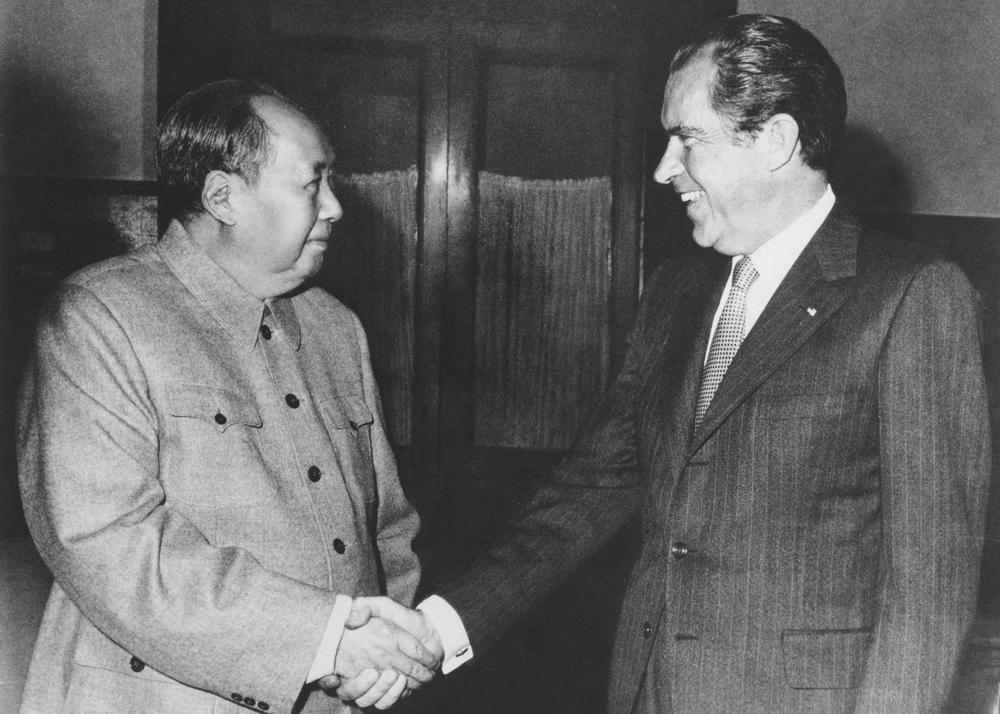FILE – Then Chinese communist party leader Mao Zedong, left, and then U.S. President Richard Nixon shake hands as they meet in Beijing on Feb. 21, 1972. At the height of the Cold War, U.S. President Richard Nixon flew into communist China’s center of power for a visit that over time would transform U.S.-China relations and China’s position in the world in ways that were unimaginable at the time. (AP Photo, File)
BEIJING (AP) — At the height of the Cold War, U.S. President Richard Nixon flew into communist China’s center of power for a visit that, over time, would transform U.S.-China relations and China’s position in the world in ways that were unimaginable at the time.
The relationship between China and the United States was always going to be a challenge, and after half a century of ups and downs, is more fraught than ever. The Cold War is long over, but on both sides there are fears a new one could be beginning. Despite repeated Chinese disavowals, America worries that the democratic-led world that triumphed over the Soviet Union could be challenged by the authoritarian model of a powerful and still-rising China.
“The U.S.-China relationship has always been contentious but one of necessity,” said Oriana Skylar Mastro, a China expert at Stanford University. “Perhaps 50 years ago the reasons were mainly economic. Now they are mainly in the security realm. But the relationship has never — and will never — be easy.”
Nixon landed in Beijing on a gray winter morning 50 years ago on Monday. Billboards carried slogans such as “Down with American Imperialism,” part of the upheaval under the Cultural Revolution that banished intellectuals and others to the countryside and subjected many to public humiliation and brutal and even deadly attacks in the name of class struggle.
Nixon’s 1972 trip, which included meetings with Chairman Mao Zedong and a visit to the Great Wall, led to the establishment of diplomatic relations in 1979 and the parallel severing of formal ties with Taiwan, which the U.S. had recognized as the government of China after the communists took power in Beijing in 1949.
Premier Zhou Enlai’s translator wrote in a memoir that, to the best of his recollection, Nixon said, “This hand stretches out across the Pacific Ocean in friendship” as he shook hands with Zhou at the airport.
For both sides, it was a friendship born of circumstances, rather than natural allegiances.
China and the Soviet Union, formerly communist allies, had split and even clashed along their border in 1969, and Mao saw the United States as a potential counterbalance to any threat of a Soviet invasion.
Nixon, embroiled in the Watergate scandal at home, was seeking to isolate the Soviet Union and exit a prolonged and bloody Vietnam War that had divided American society. He hoped that China, an ally of communist North Vietnam in its battle with the U.S.-backed South, could play a role in resolving the conflict.
The U.S. president put himself “in the position of supplicant to Beijing,” said June Teufel Dreyer, a Chinese politics specialist at the University of Miami. Chinese state media promoted the idea that a “prosperous China would be a peaceful China” and that the country was a huge market for American exports, she said.
It would be decades before that happened. First, the U.S. became a huge market for China, propelling the latter’s meteoric rise from an impoverished nation to the world’s second largest economy.
Nixon’s visit was a “pivotal event that ushered in China’s turn outward and subsequent rise globally,” said the University of Chicago’s Dali Yang, the author of numerous books on Chinese politics and economics.
Two years after Mao’s death in 1976, new leader Deng Xiaoping ushered in an era of partial economic liberalization, creating a mix of state-led capitalism and single-party rule that has endured to this day.
China’s wealth has enabled a major expansion of its military, which the U.S. and its allies see as a threat. The Communist Party says it seeks only to defend its territory. That includes, however, trying to control islands also claimed by Japan in the East China Sea and by Southeast Asian nations in the South China Sea, home to crucial shipping lanes and natural resources.
The military has sent a growing number of warplanes on training missions toward Taiwan, a source of friction with the United States. China claims the self-governing island off its east coast as its territory. The U.S. supplies Taiwan with military equipment and warns China against any attempt to take it by force.
Still, Nixon’s trip to China was touted afterward as the signature foreign policy achievement of an administration that ended in ignominy with Watergate.
Embarking on the process of bringing China back into the international fold was the right move, but the past half-century has yet to put relations on a stable track, said Rana Mitter, professor of Chinese history and modern politics at Oxford University.
“The U.S. and China have still failed to work out exactly how they will both fit into a world where they both have a role, but find it increasingly hard to accommodate each other,” he said.
Chinese officials and scholars see the Nixon visit as a time when the two countries sought communication and mutual understanding despite their differences. Zhu Feng, the dean of the School of International Studies at Nanjing University, said the same approach is key to overcoming the current impasse.
“The commemoration of Nixon’s visit tells us whether we can draw a kind of power from history,” he said.
Though his trip to China gave the U.S. leverage in its Cold War rivalry with the Soviet Union, America now faces a new geopolitical landscape — with echoes of the past.
The Soviet Union is gone, but the Russian and Chinese leaders, Vladimir Putin and Xi Jinping, are finding common cause as they push back against U.S. pressure over their authoritarian ways. The Vietnam War is over, but America once again finds its society divided, this time over the pandemic response and the last presidential election.
U.S. President Joe Biden has said he wants a more predictable relationship with China but major differences over trade and human rights make mutual understanding elusive. The prospect of long-term stability in ties raised by Nixon’s visit seems to be ever farther out of reach.
“China-U.S. relations are terrible,” said Xiong Zhiyong, a professor of international relations at China Foreign Affairs University. “There are indeed people hoping to improve relations, but it is utterly difficult to achieve.”
Associated Press researcher Yu Bing contributed.
Copyright 2021 Associated Press. All rights reserved.






























You must be logged in to post a comment Login